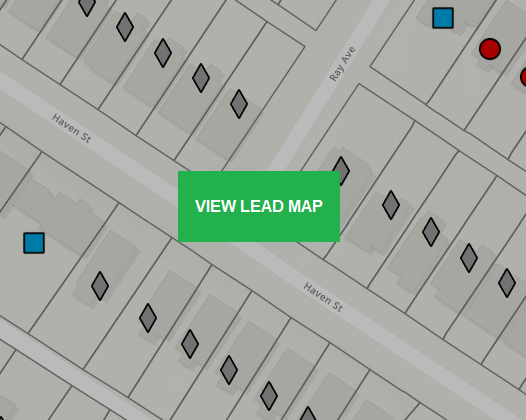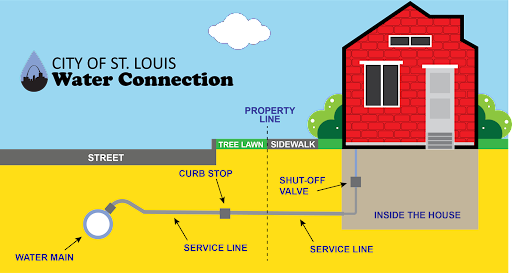City of St. Louis Water Division
Niraj S. Patel, Water Commissioner
In October 2024, the U.S. Environmental Protection Agency issued a final rule strengthening protections for lead and copper levels in drinking water [www.epa.gov] and outlining requirements for the replacement of lead service lines. To comply with this rule, the City of St. Louis is now updating its inventory of water service line materials including lead service lines. Learn how to identify and report the material of your service line.
In November 2024, the City of St. Louis Water Division contacted through the mail all property owners whose service line material is categorized as lead, galvanized requiring replacement, or unknown. Water customers were asked to respond to a survey online or by phone to help the Water Division update its inventory.
The Missouri Department of Natural Resources has created this video guide to help identify your service line material [www.youtube.com]
Service lines are entirely owned by the property owner.
The City of St. Louis Water Division is aggressively pursuing grant funding to pay for replacement of lead service lines on behalf of the property owners; this program will require applications and have eligibility requirements. At this time, City ordinances do not allow for the replacement of privately owned lead service lines using revenues collected through water rates. The City is developing a zero-interest loan program to assist property owners who choose to replace their lead service lines at their own expense.
Currently, property owners are responsible for replacing service lines, because service lines are owned by the property owner. However, the City of St. Louis has applied for federal funding, through the Bipartisan Infrastructure Law, to provide financial assistance for qualifying property owners seeking to replace lead service lines. While the City is developing our lead service line replacement plan, we cannot currently give more specific information about this assistance until the plan has been completed and a replacement program to distribute the funding has been implemented.
Exposure to lead in drinking water can cause serious health effects in all age groups. Infants and children can have decreases in IQ and attention span. Lead exposure can result in new learning and behavioral problems or exacerbate existing learning and behavioral problems. The children of women who are exposed to lead before or during pregnancy can have an increased risk of these adverse health effects. Adults can have increased risks of heart disease, high blood pressure, kidney, or nervous system problems.
Lead in drinking water, although rarely the sole cause of lead poisoning, can significantly increase a person’s total lead exposure. Infants who drink baby formulas and concentrates that are mixed with water containing lead are particularly at risk. The EPA estimates that drinking water can make up 20% or more of a person’s total exposure to lead.
For more than 20 years, the City has been treating its water with an optimized corrosion control treatment strategy, which minimizes the absorption of lead from customers' service lines or internal plumbing. The Water Division routinely tests City water, and this treatment has been shown to be effective in keeping lead levels in customers' homes well below the U.S. Environmental Protection Agency action level of 15 parts per billion, and also well below the 10 ppb action level set to take effect in 2027. The Water Division tests water quality at the treatment plants multiple times a day and tests the water at a representative sample of homes with lead service lines to meet the EPA’s regulatory requirements for compliance.
The Lead Service Line public viewer provides information about the private-side material of your water service line. Simply enter the address you want to look up, and the map will show you the material of your service line.
This information is based on the best-available data the City of St. Louis has at this time. The city continually updates its service line data based on current information and records it receives. You can help us improve the map by verifying your service line material on private property. If you have information related to your service line material that is not reflected correctly in our records, please complete the self reporting survey.
Instructions on how to identify your service line material can be found at the top of the survey. To learn about funding for lead service line replacement, click here.

The City of St. Louis Water Division has optimized its treatment process so that the corrosion of internal plumbing is highly unlikely. This treatment prevents The City of Saint Louis from experiencing a lead crisis that has been seen in other American cities. However, if present, elevated levels of lead can cause serious health problems.
Exposure to lead in drinking water can cause serious health effects in all age groups. Infants and children can have decreases in IQ and attention span. Lead exposure can lead to new learning and behavior problems or exacerbate existing learning and behavior problems. The children of women who are exposed to lead before or during pregnancy can have increased risk of these adverse health effects. Adults can have increased risks of heart disease, high blood pressure, kidney or nervous system problems.
Lead in drinking water is primarily from materials and components associated with water service lines and home plumbing. While there are no lead water mains, the City Water Division cannot control the variety of materials that property owners use in plumbing components. There are three major ways lead can get into water:
When your water has been sitting for several hours, you can minimize the potential for lead exposure by flushing your tap for 1 to 2 minutes before using water for drinking or cooking. If you are concerned about lead in your water, you may wish to have your water tested. Information on lead in drinking water, testing methods, and steps you can take to minimize exposure is available from the Safe Drinking Water Hotline (Phone: 800-426-4791) or at http://www.epa.gov/safewater/lead.
The City of Saint Louis’ water supply is carefully monitored to make sure that residents are protected from lead that could be found in drinking water. The Water Division is required by law to routinely test drinking water from homes with lead service lines to ensure that corrosion control treatment strategy is effectively working.
The Water Division is responsible for the treatment and distribution of safe drinking water within our network of underground water mains. Once the water flows from the water main in the street to our customers’ service connections, it’s safe delivery becomes the customer’s responsibility. As the service line is owned and maintained by the property owner, it is their responsibility to repair faulty plumbing that connects the water mains to the home as well as the plumbing inside the home.
There are homes in the City of Saint Louis that may have a water service line (the pipe running from the water main to the home) that is made of lead. Interior plumbing and fixtures inside the home may also contain lead. Replacing an older brass faucet or valve may be a simple way to reduce the lead.
The following Diagram illustrates a typical water service from water main to home:

To find out if your water service line is made of lead, follow these steps or use the How-To Identify Your Service Line Material Guide (PDF): How-To Identify Your Water Service Line Material.pdf
Having a lead service line does not mean your home’s water has high levels of lead. Corrosion control treatment, performed in The City of Saint Louis for more than 20 years, has been shown to be effective in keeping lead levels in customers' homes below the U.S. Environmental Protection Agency (EPA) standard of fifteen parts per billion (15ppb).
In addition to replacing lead pipes and plumbing, there are immediate steps you can take to reduce the chances of lead exposure related to water use, such as flushing your tap when using it for drinking or cooking if your water has been sitting idle for several hours.
The Water Division conducts regular sampling and testing of lead service lines. To volunteer for our lead sampling and testing program, please email lcrsamples@stlwater.com
The Water Division is currently updating inventory records of all service lines. If you would like to report your service line material type, please follow this How-To Guide to help determine if you have a lead service line. To report your service line material type, please Click HERE.
The drinking water in The City of Saint Louis meets or exceeds state and federal water quality standards. Our water quality data can be found in our annual Consumer Confidence Report (CCR). To view our CCR, please visit The Water Division’s drinking water quality page.